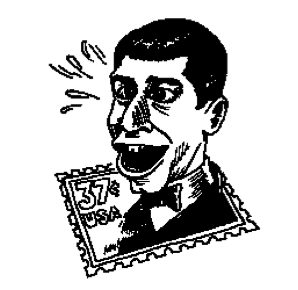A peculiar thing happens midway through Jerry Lewis’s 1961 film The Errand Boy (directed by Jerry Lewis). The titular doof (Jerry as “Morty S. Tashman”) is wandering the aisles of a Hollywood prop room when he hears a “psst” coming from an upper shelf. He climbs to investigate. Pushing aside cat puppets, girl puppets, other puppets (it must be puppet storage), he discovers a Little Clown puppet, lying there like a stuffed sock. Stuffed—this tells us something, and indeed a cut to the other side of the shelf reveals that the hand puppet is filled, there’s an arm in there trailing off down the bottom of the screen. Jerry reaches out for it, but it pulls away, disappearing below. Then, coyly, the Little Clown puts its plastic, Ping-Pong-ball–sized head, all bright eyes, monkey grin, and pointy hat, just over the edge and stares at Jerry. Shyly, it waves. Jerry waves back with a slight movement of his own fingers.
The Little Clown raises itself, rests its head on its arm, then—ah!—gets an idea and disappears below. He returns with a lollipop, which he offers to Jerry, dropping it on the shelf and pushing it hesitantly, trustingly, cutely toward him. Jerry takes it and rips off the plastic wrapper with his mouth (say, where’s his other hand?) while the Little Clown bounces up and down in delight (oh! He’s a happy fellow!). Jerry keeps sucking, eyes crossed at this really phenomenal lollipop and the Little Clown waves again (he likes to wave). But so much fun has made the Little Clown tired—he stretches and rubs his eyes. Jerry, in instant sympathy, becomes sleepy himself (what is the nature of the Little Clown’s strange hold on his attention?).
The wee creature drops out of sight again and returns with—a little bed. He buries his face in his appendages before attempting to climb in (I think he’s saying a little prayer). Then the ordeal begins. The Little Clown can never really climb into bed, of course, because he is attached to someone’s arm. If we ever begin to forget this, the film cuts to a position from behind the Clown’s side of the shelf—yup, that’s an arm OK. And the arm is placed at a 90-degree angle to the bed—no way can he even begin to stretch out without bringing an elbow into the frame. (This is when I start to itch.)
To prolong the frustration, the Little Clown pulls the little felt blanket off the bed in an effort to—I don’t know, he certainly can’t cover himself. And he doesn’t, just wads it on the edge of the bed (maybe an attempt to hide his extension)....
You have reached your article limit
Sign up for a digital subscription and continue reading all new issues, plus our entire archives, for just $1.50/month.
Already a subscriber? Sign in





